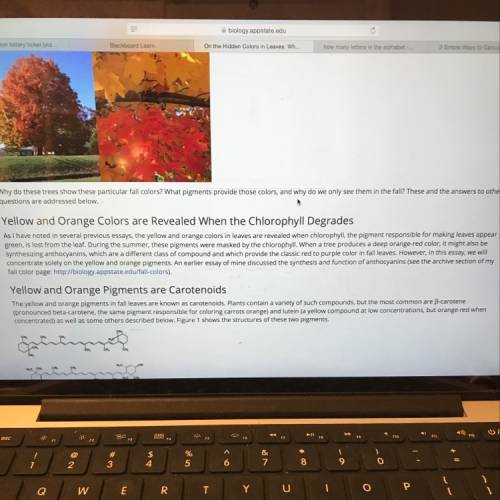
Carotenoids are red, orange, or yellow pigments found in many plants. usually we see these accessory pigments only in the fall. why aren't the red, orange, and yellow colors visible all year long? a) the carotenoids have much less energy than chlorophyll. b) the accessory pigments only absorb light; they do not reflect light. c) chlorophyll is more abundant in the leaves and masks the accessory pigments. d) plants only reflect wavelengths of visible light that represent the color green.

Answers: 1
Another question on Biology

Biology, 21.06.2019 20:00
Read the following scenario to answer the following question. over the past 60 years, many amphibian species have experienced significant population declines, and some species have become extinct. scientists suspected that local human activities such as the destruction of wetlands, regional pollution, and deforestation were the main reasons for these losses. however, research over the past 20 years reveals significant amphibian population declines in protected areas of the world, such as nature preserves and parks. these global declines suggest widespread problems including increased ultraviolet radiation, acid rain, and disease. in switzerland, for example, 14 of the 20 native amphibian species are threatened with extinction. when most populations of a wide-ranging amphibian species are lost and the few remaining populations are widely separated, we expect to see that a. the founder effect becomes increasingly important b. microevolution no longer occurs c. gene flow between populations is reduced d. artificial selection becomes a greater factor in microevolution
Answers: 2

Biology, 22.06.2019 02:30
What is the inability of an individual or a society to achieve a minimum standard of living known as ?
Answers: 1

Biology, 22.06.2019 03:00
Which of the following are the ingredients that go into the plant and are needed for photosynthesis? select all that apply. 1.) soil 2.) seeds 3.) carbon dioxide 4.) minerals 5.) glucose (sugar) 6.) water 7.) light energy (sunlight) 8.) oxygen 9.) air
Answers: 2

Biology, 22.06.2019 06:00
The empty trna moves off and picks up another matching amino acid from the cytoplasm in the cell. the anticodon of the trna, with its attached amino acid, pairs to the codon of the mrna, which is attached to a ribosome. this sequence is repeated until the ribosome reaches a stop codon on the mrna, which signals the end of protein synthesis. the ribosome forms a peptide bond between the amino acids, and an amino acid chain begins to form. when a second trna with its specific amino acid pairs to the next codon in sequence, the attached amino acid breaks from the first trna and is bonded to the amino acid of the second trna.
Answers: 1
You know the right answer?
Carotenoids are red, orange, or yellow pigments found in many plants. usually we see these accessory...
Questions



Mathematics, 27.08.2020 03:01


English, 27.08.2020 03:01



Mathematics, 27.08.2020 03:01

Mathematics, 27.08.2020 03:01



English, 27.08.2020 03:01



Mathematics, 27.08.2020 03:01

Mathematics, 27.08.2020 03:01

Mathematics, 27.08.2020 03:01



Biology, 27.08.2020 03:01




